前言
ViewModel 作为 Jetpack 中的明星组件,相信大家都对其有一定的了解。在 Google 的官方介绍中也详细的罗列了 ViewModel 的优点,如:
- 可以提供和管理UI界面数据。(将加载数据与数据恢复从 Activity or Fragment中解耦)
- 可感知生命周期的组件。
- 不会因配置改变而销毁。
- 可以配合 LiveData 使用。
- 多个 Fragment 可以共享同一 ViewModel。
- 等等等….
你也可以通过下列两个视频,更为详细的了解 ViewModel:
在本篇文章中,不会讲解 ViewModel 的使用方式及使用 ViewModel 的原因,而是着重于讲解 ViewModel 的原理。通过阅读本篇文章你能了解到:
- ViewModel 在 Activity 中的绑定过程。
- ViewModel 在 Activity 中不会因配置改变而销毁的原理。
- ViewModel 在 Fragment 中的绑定过程。
- ViewModel 在 Fragment 中不会因配置改变而销毁的原理。
- ViewMode 能在 Fragment 中共享的原理。
希望通过该篇文章,大家能对 ViewModel 有更深入的了解。
ViewModel 与 Activity 的绑定过程
一般情况下使用 ViewModel,我们一般会先声明自己的 ViewModel,并在 Activity 中的 onCreate 方法中使用 ViewModelProviders 来创建 ViewModel。 如下代码所示:
1 | MyViewModel model = ViewModelProviders.of(this).get(MyViewModel.class); |
在谷歌的最新代码中,不推荐使用
ViweModelProviders(注意是有s的呦),而是直接使用ViewModelProvider的构造函数来创建ViewModelProvider对象。
通过使用 ViewModelProviders 类的 of() 方法,我们会得到一个 ViewModelProvider 对象。如下代码所示:
1 | public static ViewModelProvider of(@NonNull FragmentActivity activity) { |
ViewModelProvider 类需要我们传递 ViewModelStore 与 Factory 对象。其构造函数声明如下:
1 | //使用ViewModelStoreOwner对象构造函数 |
在 ViewModelProvider 内部,拥有三种类型构造函数:
(ViewModelStoreOwner owner):- 该构造函数使用 owner 对象的
getViewModelStore()方法来获取ViewModelStore对象,如果传入的 owner 对象也实现了HasDefaultViewModelProviderFactory接口时,那么会调用getDefaultViewModelProviderFactory()方法获取 Factory。反之,使用内部静态的NewInstanceFactory对象来创建 Factory 对象。
- 该构造函数使用 owner 对象的
(ViewModelStoreOwner owner, Factory factory):- 该构造函数使用 owner 对象的
getViewModelStore()方法来获取ViewModelStore对象,使用传递的 Factory 对象
- 该构造函数使用 owner 对象的
(ViewModelStore store, Factory factory):- 使用
ViewModelStore与Factory对象的构造函数
- 使用
Factory 接口介绍
在 ViewModelProvider 中,Factory 主要用于创建 ViewModel,Factory 的声明如下:
1 | public interface Factory { |
通过实现 Factory 接口,我们可以实现自己想要的工厂以创建所需的 ViewModel。在 Android 中有多个类都实现了该接口(如 KeyedFactory, AndroidViewModelFactory),这里以默认的 NewInstanceFactory 为例:
1 | public static class NewInstanceFactory implements Factory { |
默认情况下, NewInstanceFactory 会调用 ViewModel 的无参构造函数创建实例对象,当然如果你需要在 ViewModel 中使用其他参数,你也可以传递自定义的 Factory。
ViewModelStore 介绍
ViewModelStore 内部维护了一个 HashMap,其 key 为 DEFAULT_KEY + ViewModel的Class对象底层类规范名称,其 value 为对应 ViewModel 对象。每个 Activity 与 Fragment 都对应着一个 ViewModelStore ,用于存储所需的 ViewModel。ViewModelStore 类声明如下所示:
DEFAULT_KEY 值为:”androidx.lifecycle.ViewModelProvider.DefaultKey”
1 | public class ViewModelStore { |
Activity 中创建与获取 ViewModel 流程
ViewModel 最终的创建与获取,需要 ViewProvider 类调用 get(Class<T> modelClass)方法(该方法内部通过 ViewModelStore 与 Factory 的配合,创建并保存了所需的 ViewModel 对象),具体代码如下所示:
1 | public <T extends ViewModel> T get(@NonNull Class<T> modelClass) { |
该方法内部会调用 get(String key, Class<T> modelClass) 方法:
1 | public <T extends ViewModel> T get(@NonNull String key, @NonNull Class<T> modelClass) { |
在该方法中,会在 ViewModelStore 中根据传入的 key 获取并保存 ViewModel。其具体逻辑如下:
- 根据 key 值从 ViewModelStore 中取对应的 ViewModel。
- 判断所传入的 Class 对象是否是 ViewModel 的 Class 类或其子类的对象,如果是,直接返回。(当
Object.isInstance(class)接受的参数为null时,该方法会返回false) 如果获取的 ViewModel 为 null,会根据传入的 Factory 对象创建新的 VideModel,并将创建好的 ViewModel 放入 ViewModelStore中。
Activity 中创建与获取 ViewModel 的整体流程如下所示:
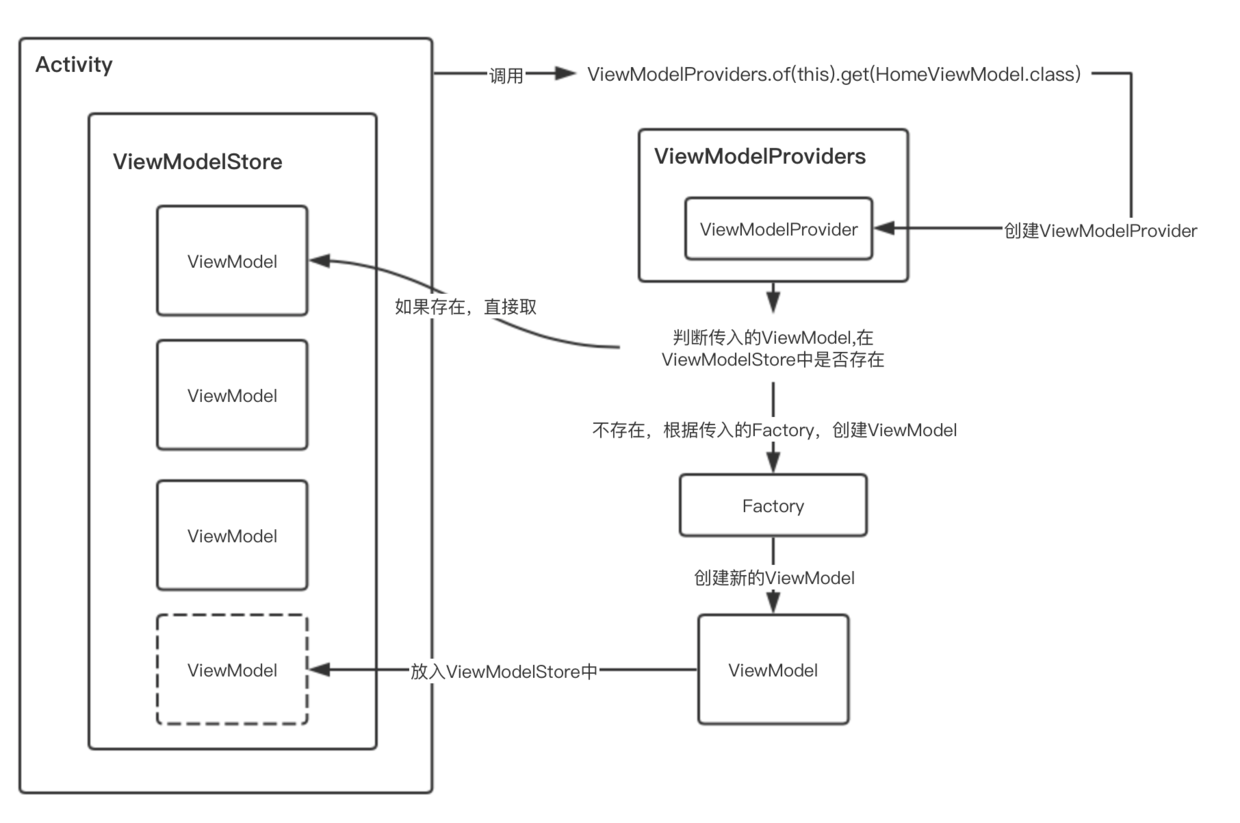
ViewModel 在 Activity 中不会因配置改变而销毁的原理
我们都知道 ViewModel 不会因为 Activity 的配置发生改变而销毁,ViewModel 作用域如下所示:
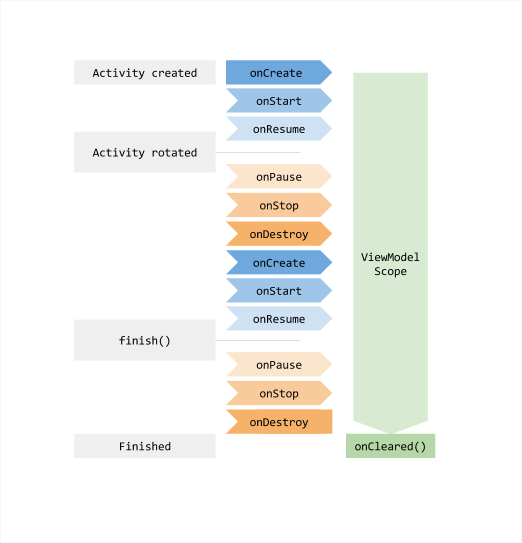
观察上图,我相信小伙伴们肯定有如下疑惑:
- 当 Activity 因配置发生改变时,系统会重新创建一个新的 Activity 。那老的 Activity 中的 ViewModel 是如何传递给新的 Activity 的呢?
- ViewModel 又是如何感知配置是否改变,进而判断是否销毁的呢?
要解决如上问题,我们需要了解 Android 中数据恢复的方式以及 Activity 生命周期中 ViewModel 实际处理流程。
数据恢复的常见方式
在 Android 系统中,需要数据恢复有如下两种场景:
- 场景1:资源相关的配置发生改变导致 Activity 被杀死并重新创建。
- 场景2:资源内存不足导致低优先级的 Activity 被杀死。
针对上述场景,分别对应三种不同的数据恢复方式。
对应场景1,不考虑在清单文件中配置
android:configChanges的特殊情况。
使用 onSaveInstanceState 与 onRestoreInstanceState
使用 onSaveInstanceState 与 onRestoreInstanceState 方法,能处理场景1与场景2的情况。当你的界面数据简单且轻量时,例如原始数据类型或简单对象(比如 String),则我们可以采用该方式。如果你需要恢复的数据较为复杂,那你应该考虑使用 ViewModle + onSaveInstanceState() (为什么要配合使用,会在下文进行讲解),因为使用 onSaveInstanceState() 会导致序列化或反序列化,而这,有一定的时间消耗。
onSaveInstanceState() 更为详细的介绍以及使用,可参考官方文档:
使用 Fragment 的 setRetainInstance
当配置发生改变时,Fragment 会随着宿主 Activity 销毁与重建,当我们调用 Fragment 中的 setRetainInstance(true) 方法时,系统允许 Fragment 绕开销毁-重建的过程。使用该方法,将会发送信号给系统,让 Activity 重建时,保留 Fragment 的实例。需要注意的是:
- 使用该方法后,不会调用 Fragment 的
onDestory()方法,但仍然会调用onDetach()方法 - 使用该方法后,不会调用 Fragment 的
onCreate(Bundle)方法。因为 Fragment 没有被重建。 - 使用该方法后,Fragment 的
onAttach(Activity)与onActivityCreated(Bundle)方法仍然会被调用。
以下示例代码展示了如何在配置发生改变时,保留 Fragment 实例,并进行数据的恢复。
1 | public class MainActivity extends AppCompatActivity { |
Fragment :
1 | public class SaveFragment extends Fragment { |
关于 Fragment 的 setRetainInstance 更多用法与注意事项,可以参看文章
Handling Configuration Changes with Fragments
使用 onRetainNonConfigurationInstance 与 getLastNonConfigurationInstance
在 Activity 中提供了 onRetainNonConfigurationInstance 方法,用于处理配置发生改变时数据的保存。随后在重新创建的 Activity 中调用 getLastNonConfigurationInstance 获取上次保存的数据。我们不能直接重写上述方法,如果想在 Activity 中自定义想要恢复的数据,需要我们调用上述两个方法的内部方法:
onRetainCustomNonConfigurationInstance()getLastCustomNonConfigurationInstance()
注意:
onRetainNonConfigurationInstance方法系统调用时机介于onStop - onDestory之间,getLastNonConfigurationInstance方法可在onCreate与onStart方法中调用。
以下代码展示了,在 Actiity 中恢复自定义的数据:
1 | public class MainActivity extends AppCompatActivity { |
在 Android 3.0 后,官方推荐使用 Fragment#setRetainInstance(true) 的方式进行数据的恢复。之所以推荐这种方式,个人猜测是为了降低 Activity 的冗余,将数据恢复的任务从 Activity 抽离出来,这更符合单一职责的设计模式。
几种数据恢复方式的总结
通过了解数据恢复的几种方式,我们能得到如下对比图:

ViewModel 的恢复
ViewModel 在官方设计之初就倾向于在配置改变时进行数据的恢复。考虑到数据恢复时的效率,官方最终采用了 onRetainNonConfigurationInstance 的方式来恢复 ViewModel 。
在 SDK 27 之前,官方一直采用
Fragment#setRetainInstance(true)的方式恢复数据。导致官方修改了其内部实现的原因,猜测是因为 Fragment 的坑,程序的扩展性等其他因素。
知道了 ViewModel 的恢复方式,那现在一起来解决我们之前的疑惑。当 Activity 因配置发生改变时,系统会重新创建一个新的 Activity 。那老的 Activity 中的 ViewModel 是如何传递给新的 Activity ?
在 Androidx 中的 Activity 的最新代码中,官方重写了 onRetainNonConfigurationInstance 方法,在该方法中保存了 ViewModelStore (ViweModelStore 中存储了 ViewModel ),进而也保存了 ViewModel,具体代码如下所示:
1 | public final Object onRetainNonConfigurationInstance() { |
当新的 Activity 重新创建,并调用 ViewModelProviders.of(this).get(xxxModel.class) 时,又会在 getViewModelStore() 方法中获取老 Activity 保存的 ViewModelStore。那么也就拿到了 ViewModel。具体代码如下所示:
1 | public ViewModelStore getViewModelStore() { |
ViewModel 何时判断是否被移除
ViewModel 最重要的特性就是不会在配置发生改变的时候被移除。其内部实现也非常简单,监听 Activity 声明周期,在 onDestory 方法被调用时,判断配置是否改变。如果没有发送改变,则调用 Activity 中的 ViewModelStore 的 clear() 方法,清除所有的 ViewModel。具体代码如下所示:
1 | public ComponentActivity() { |
ViewModel 在 Fragment 的绑定过程
在官方的最新代码实现中,Fragment 中的 ViewModel 与其宿主 Activity 有着密切的联系。要了解 ViewModel 与 Fragment 的绑定过程,我们需要先了解 FragmentManager 与 FragmentManagerViewModel 相关知识。
FragmentManager 介绍
每个 Fragment 及宿主 Activity (继承自 FragmentActivity)都会在创建时,初始化一个 FragmentManager 对象,了解 Fragment 中的 ViewModel 与 Activity 的联系的关键,就是理清这些不同阶级的栈视图。
下面给出一个简要的关系图:

- 对于宿主 Activity ,
getSupportFragmentManager()获取的是 FragmentActivity 的 FragmentManager 对象; - 对于 Fragment ,
getFragmentManager()是获取的父 Fragment (如果没有,则是 FragmentActivity )的 FragmentManager 对象,而getChildFragmentManager()是获取自身的 FragmentManager 对象。
FragmentManagerViewModel 介绍
每个 Fragment 创建时,都会创建一个 FragmentManagerViewModel 对象,在该对象中主要存储其 子Fragment 的 ViewModelStore 与 FragmentManagerViewMoel。具体结构如下所示:
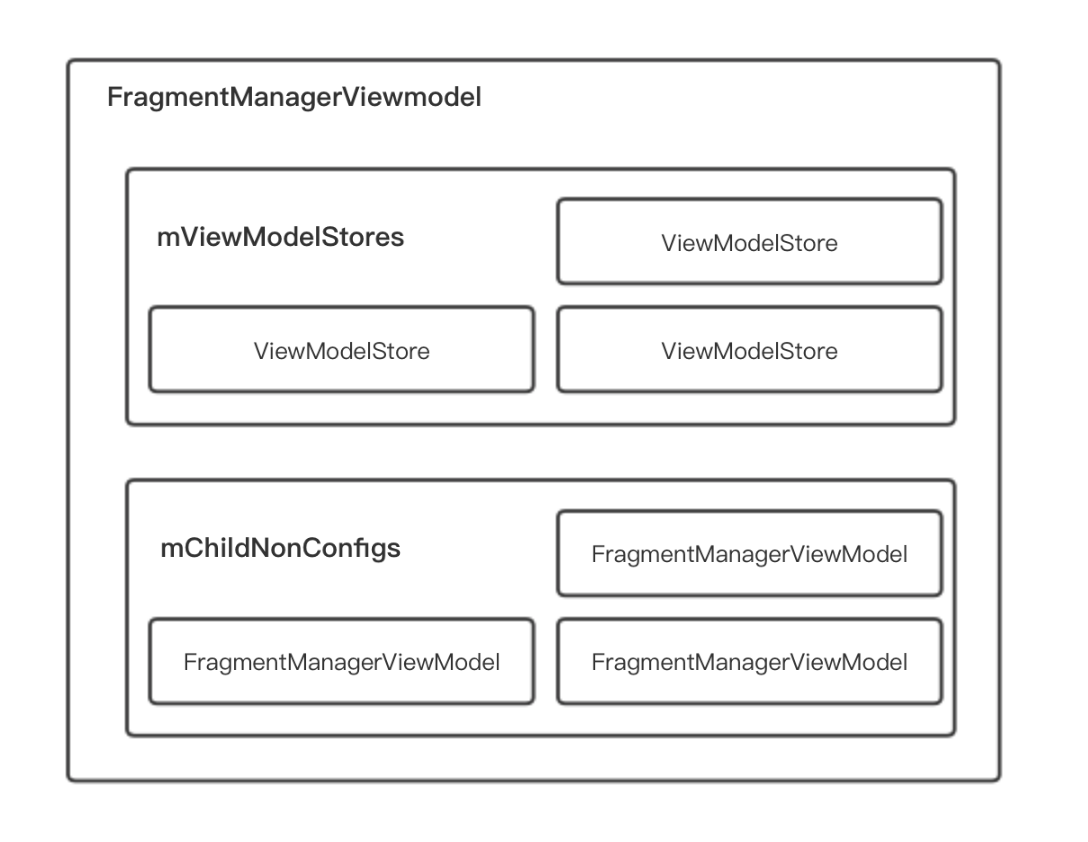
在 FragmentManagerViewModel 中:
- mViewModelStore 是类型为
<String, FragmentManagerViewModel>的 HashMap - mChildNonConfigs 是类型为
<String, ViewModelStore>的 HashMap
上述两个 Map 对应的 Key 值都为 Fragment 的唯一 UUID。该 UUID 会在 Fragment 对象创建时自动生成。也就是每个 Fragment 对应唯一 UUID。
ViewModel 在 Fragment 绑定具体流程
ViewModel 与 Fragment 的绑定流程比较复杂,主要分为三个流程:
- 第一步:在宿主 Activity 创建时,默认会在其
FramgentManager中创建一个 FragmentManagerViewModel。同时将生成的 FragmentManagerViewModel 存储在其本身的 ViewModelStore 中。同时使用自身的FragmentManager - 第二步:在 Fragment 创建时,从
宿主Activity或父Fragment中的FramgentManager中获取对应的 FragmentManagerViewModel,并使用自身的ChildFragmentManager中mNonConfig变量进行保存。 - 第三步:将 Fragment 中所创建的 ViewModel 与其自身的 ViewModelStore 关联 ,并自身的 ViewModelStore 存储在
mNonConfig所指向的 FragmentManaerViewModel 中的mViewModelStores中。
下面我将结合源码对这三个流程进行详细的介绍。
第一步流程
在宿主 Activity 创建时,默认会在其
FramgentManager中创建一个 FragmentManagerViewModel。同时将生成的 FragmentManagerViewModel 存储在其本身的 ViewModelStore 中。同时使用自身的FragmentManager
FragmentActivity 中的 onCreate 方法:
1 | protected void onCreate(@Nullable Bundle savedInstanceState){ |
mFragments是 FragmentController,内部通过 FragmentHostCallback 间接控制 FragmentManager。
该方法最终会执行 FragmentActivity 中 FragmentManager 的 attachController 方法:
1 | void attachController(@NonNull FragmentHostCallback<?> host, |
因为传入的 parent = null,且 Activity 默认实现了 ViewModelStoreOwner 接口,所以会获取 Activity 中的 ViewModelStore,接着调用 FragmentManagerViewModel 的 getInstance() 方法:
1 | static FragmentManagerViewModel getInstance(ViewModelStore viewModelStore) { |
在该方法中,会创建 FragmentManagerViewModel,并将其添加到 Activity 中的 ViewModelStore 中。
整体流程如下所示:
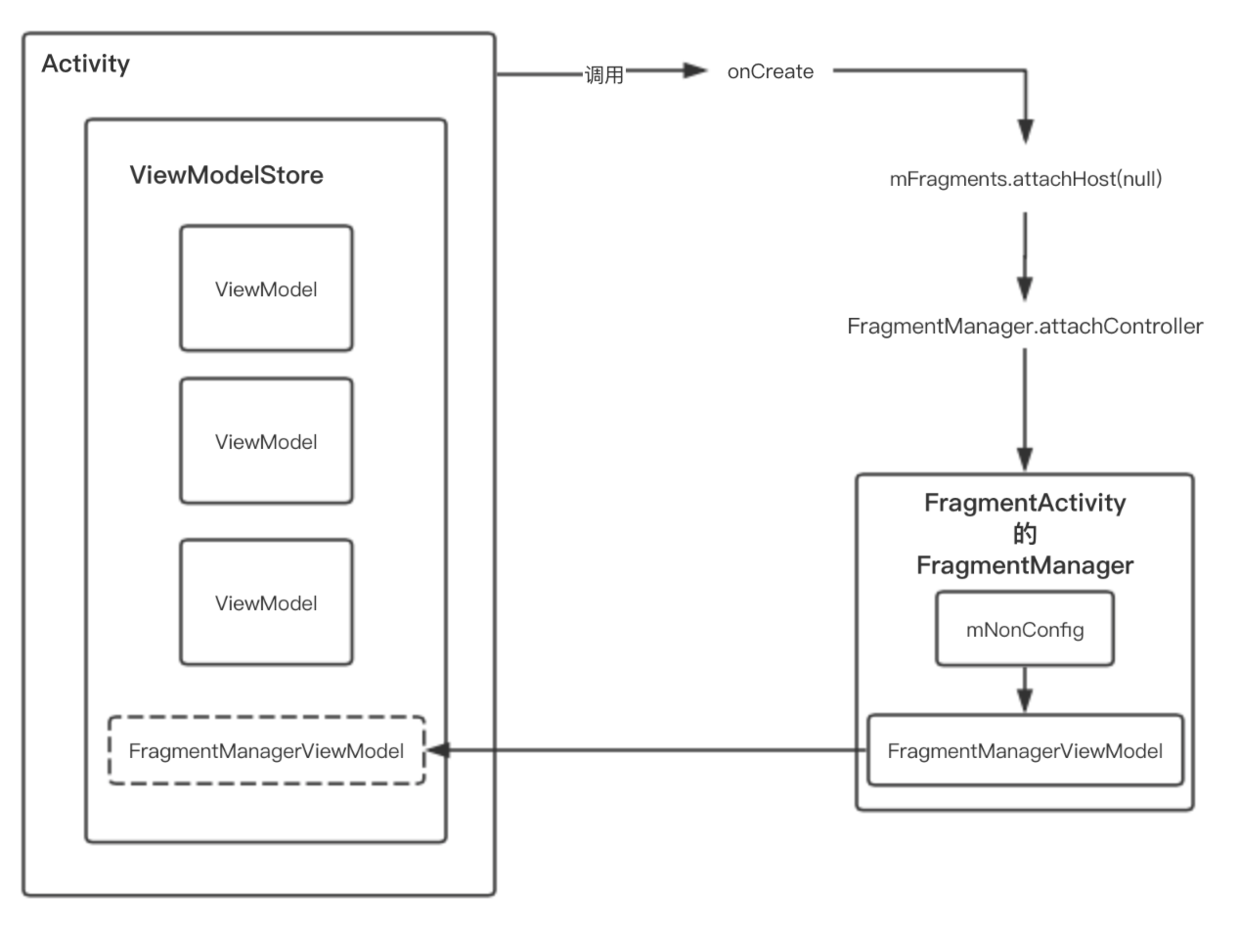
第二步流程
在 Fragment 创建时,从
宿主Activity或父Fragment中的FramgentManager中获取对应的 FragmentManagerViewModel,并使用自身的ChildFragmentManager中mNonConfig变量进行保存。
当 Fragment 与 Activity 关联时,在其 performAttach() 方法中
1 | void performAttach() { |
该方法会调用 Fragment 中 ChildFragmentManager 中的 attachController 方法如下所:
1 | void attachController(@NonNull FragmentHostCallback<?> host, |
注意,当 Fragment 是
子Fragment时,parent.fragmentManager 的值为父Fragment 的 FragmentManager,否则为 Activity 中的 FragmentManager。
继续追踪 FragmentManager 下的 getChildNonConfig 方法:
1 | private FragmentManagerViewModel getChildNonConfig(Fragment f){ |
mNonConfig 本身为 FragmentManagerViewModel,我们继续跟踪:
1 | FragmentManagerViewModel getChildNonConfig(Fragment f){ |
在该方法中,会从 Activity 中的 FragmentManagerViewModel 中的 mChildNonConfigs 中获取 Fragment 的 FragmentManagerViewModel,如果有,直接返回。反之,存入mChildNonConfigs 中。
整体流程如下所示:
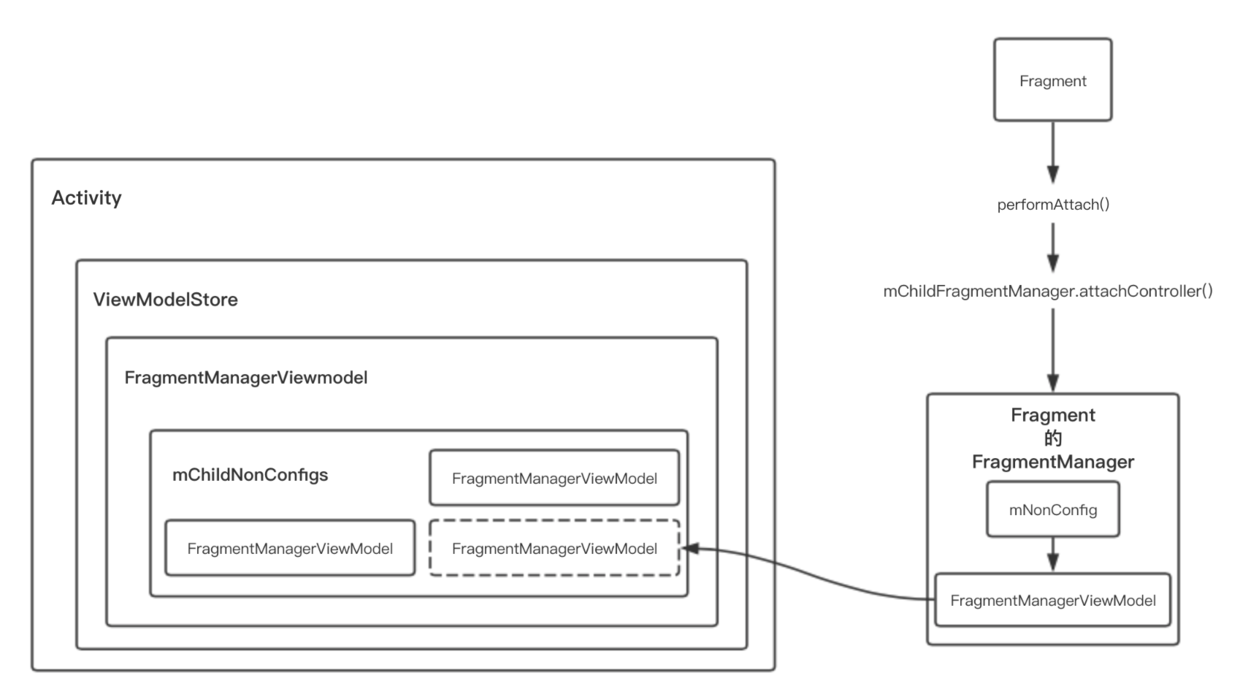
第三步流程
将 Fragment 中所创建的 ViewModel 与其自身的 ViewModelStore 关联 ,并将该 ViewModelStore 存储在
mNonConfig所指向的 FragmentManaerViewModel 中的mViewModelStores中。
在 Fragment 中,ViewModelStore 是通过其 FragmentManager 创建与获取的。具体代码如所示:
1 | public ViewModelStore getViewModelStore() { |
注意,当 Fragment 是
子Fragment时,mFragmentManager的值为 父Fragment 的 FragmentManager,否则为 Activity 中的 FragmentManager。
继续追踪 FragmentManager 下的 getChildNonConfig 方法:
1 | ViewModelStore getViewModelStore(@NonNull Fragment f) { |
mNonConfig 本身为 FragmentManagerViewModel,最终会走 getViewModelStore 方法。
1 | ViewModelStore getViewModelStore(@NonNull Fragment f) { |
在该方法中最终会将 Fragment 的 ViewModelStore 存入 FragmentManagerViewModel 中的 mViewModelStores 集合中。
那么 Fragment 的创建并获取 ViewModel 的流程如下所示:

ViewModel 在 Fragment 中不会因配置改变而销毁的原理
ViewModel 在 Fragment 中不会因配置改变而销毁的原因其实是因为其声明的 ViewModel 是存储在 FragmentManagerViewModel 中的,而 FragmentManagerViewModel 是存储在宿主 Activity 中的 ViewModelStore 中,又因 Activity 中 ViewModelStore不会因配置改变而销毁,故 Fragment 中 ViewModel 也不会因配置改变而销毁。
当然在 Google 的代码实现中,也能很好的处理 Fragment 嵌套的情况。在下述例子中展示了 Fragment 嵌套下 ViewModel 存储的情况。

在上图中,我们在 Activity 中 分别添加了 Fragment A、B、C。并在 Fragment C 中有嵌套了 Fragment D、E、F。
结合本篇文章所讲解的知识,我们能得到如下结构:

从上图中,我们可以看出,当存在嵌套 Fragment 的情况下,ViewModel 总是以线性的结构进行存储。在这种结构下,就能让宿主 Activity 良好的统一管理与所有的 ViewModel。
ViewModel 能在 Fragment 中共享的原理
ViewModel 的另一大特性就是能在 Fragment 中共享数据。还是以上图例:
假如我们想 Fragment D 获取 Fragment A 中的数据,那么我们只有在 Activity 中的 ViewModelStore 下添加 ViewModel。只有这样,我们才能在不同 Fragment 中获取相同的数据。这也是为什么在 Fragment 中使用共享的 ViewModel 时,我们要在调用ViewModelProvider.of() 创建 ViewModel 时需要传入 getActivity() 的原因。
具体例子如下所示:
1 | public class SharedViewModel extends ViewModel { |
最后
站在巨人的肩膀上,才能看的更远~